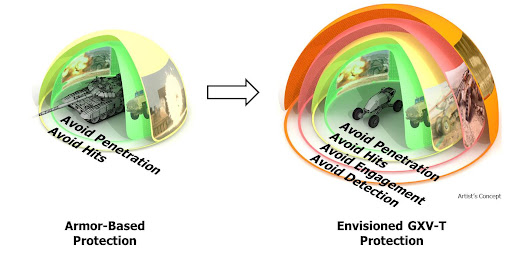August 19
This artist’s rendering was released by the Defense Advanced Research Projects Agency in an attempt to explain its Ground X-Vehicle Technology program. It seeks to protect vehicles better from explosions without increasing armor. (Image released by DARPA) 
When insurgents began laying improvised explosive devices by the dozen in Iraq to kill U.S. troops in 2004, no immediate answer was available. Soldiers and Marines responded by hanging any kind of scrap metal they could find to better protect their Humvees. But “Hillbilly armor,” as thetroops sometimes called it, weighed the vehicles down, made them prone to rollovers and still didn’t cover the bottom sides of the vehicle most exposed to a blast.
The Pentagon’s fight to keep the weight down on vehicles has never really ended. To fight off IEDs, it eventually fielded MRAPs, short for Mine Resistant Ambush Protected vehicles. The beefy trucks have an armored V-shaped hull that deflects roadside blasts, and are credited with saving thousands of lives in Iraq and Afghanistan. But even the smallest ones still weigh in excess of 25,000 pounds, and are prone to rollovers that kill troops.
These artist’s renderings were released by the Defense Advanced Projects Agency in an attempt to explain its Ground X-Vehicle Technology program. (Image released by DARPA)
This artist’s rendering was released by the Defense Advanced Projects Agency in an attempt to explain its Ground X-Vehicle Technology program. It seeks to protect vehicles better from explosions without increasing armor. (Image released by DARPA)
With all that in mind, a Pentagon agency has launched a new, high-tech effort to protect troops while reducing armor. The Ground X-Vehicle Technology Program is investigating options available to improve both the mobility of military vehicles and the safety for troops inside. The goals, expressed here by the Defense Advanced Research Projects Agency, appear to be a tall order:
Reduce vehicle size and weight by 50 percent
Reduce onboard crew needed to operate a vehicle by 50 percent
Increase vehicle speed by 100 percent
Access 95 percent of all terrain
Reduce the enemy’s ability to detect and target an approaching vehicle
DARPA says that some ways to reach those goals could include “radically enhanced mobility,” figuring out ways to autonomously dodge threats and re-position armor, and improving situational awareness for troops inside the vehicle. The agency also wants to explore making it more difficult for adversaries to see and hear the vehicle.
Despite the program’s futuristic goals, DARPA says it plans to develop technology for the program over two years after initial contracts are awarded around April 2015.
Dan Lamothe covers national security for The Washington Post and anchors its military blog, Checkpoint.
No comments:
Post a Comment